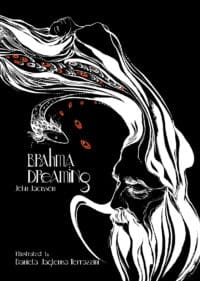RESEARCH: 4/5
WRITING STYLE: 5/5
ILLUSTRATIONS: 5/5
ENTERTAINMENT QUOTIENT: 5/5
Hindu mythology is a vast subject; multi-coloured, multi-layered, and very complex.
With 330 million Gods and incarnations, it is like an unsolvable maze, an incalculable equation.
The three principal Gods of Hindus are Brahma, Vishnu and Shiva, together known as Trimurti; Brahma – the creator, Vishnu – the preserver, and Shiva – the destroyer.
Together, they keep the cycle of life moving.
Brahma meditates and dreams, and in his dreams he creates everything – us, the universe, earth, plants, rivers, deserts, birds, animals and insects.
Vishnu rests on a serpent and once in a while incarnates in human form to protect the world from evil.
When evil reaches a tipping point, Shiva destroys the world with his third eye so that Brahma can create the world anew.
Hindu mythology brims with tales of these three Gods; tales of creation, tales of preservation and tales of destruction.
“The sound of Aum filled the whole of the space and the void, and Aum was in everywhere and through everywhere and was everywhere. The sound of Aum became power and the power had a form with three faces. They were the faces of the Lords of Creation – Brahma the Creator, Vishnu the Preserver and Shiva the Destroyer.”
John Jackson’s ‘Brahma Dreaming’ is a collection of these mythological tales, written in a simple and straightforward manner. His narration is unassuming, and he writes as it is.
No attempt is made to give logical explanations behind the divine acts and interventions. For a modern and analytical reader, there are scores of retellings available which tend to justify each and every act in our myths.
‘Brahma Dreaming’ comes as a fresh relief because it narrates mythology as our grandfathers knew it.
The book, divided into three parts – tales of creation, tales of preservation and tales of destruction, starts with the birth of Brahma, Vishnu and Shiva from the energy of Aum, and ends with the death of Krishna, in the hands of a hunter, Jara.
The three parts of the book are again divided into short stories, each describing an interesting event.
‘The Milk Ocean’ tells the story of Devas and Asuras churning the ocean for Amrit. ‘The Lie’ tells the story of Kadru, and how she invented lying. ‘The Fish’ narrates the Hindu version of ‘Noah’s Ark’.
The tales of destruction has stories about Shiva and Parvati’s marriage, the birth of Kartikeya and Ganesha, Savitri and Satyavan, etc.
The tales of preservation mostly covers Ramayana and Mahabharata.
The book is enriched with wonderful illustrations by Daniela Jaglenka Terrazzini. These are very intricate and quite unlike the images, we hold in our minds. They depict characters with a very interesting mix of Indian features and western attires.
To someone who is new to Indian mythology and would like to know the basic premise behind the major events in it, John Jackson’s ‘Brahma Dreaming’ is the perfect answer and a must-read.
